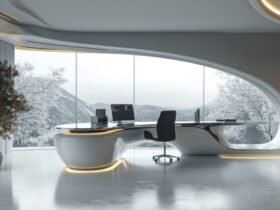Lighting is an essential element in the design of any space. More than just a practical necessity, it has the power to transform environments, create moods, and enhance architecture. In this realm, the pinnacle of lighting design is custom lighting, where individuality and creativity merge to produce not just light fixtures but pieces of art that are integral to the identity of a space.
The Significance of Custom Lighting
The importance of custom lighting lies in its ability to meet the specific needs and visions of a project. Standard lighting solutions can be suitable for general purposes, but they often lack the finesse and adaptability that custom designs bring. Personalised lighting can address the unique dimensions, colours, and style of a space, ensuring that the lighting is not just adequate but extraordinary. It is in these details that the art of custom lighting truly shines.
Read More: Creating a Relaxing Living Space: Combining Style, Comfort, and Function
For designers and architects alike, custom lighting represents an opportunity to break free from the constraints of mass-produced fixtures. It allows them to infuse spaces with a sense of personality and craftsmanship that off-the-shelf products cannot replicate. The bespoke nature of this approach means each piece can serve as a focal point or seamlessly integrate with the overall aesthetic, depending on the design intent.
Elements of Custom Lighting Design
Creating effective custom lighting involves several key elements. First and foremost is an in-depth understanding of the space itself—the dimensions, necessary light levels, existing decor, and the activities that will take place there. From this foundation, designers can envision a lighting scheme that not only illuminates but also complements and enhances the space.
Material selection is another critical factor in crafting custom lighting. The choice of materials can greatly affect both the light quality and the piece’s visual appeal. From traditional materials like glass and metal to innovative uses of wood, fabric, or even recycled components, the possibilities are endless and can dramatically influence the ambiance of a room.
Technical expertise is equally vital. Knowledge of lighting technology, energy efficiency, and safety standards ensures that the beautiful designs are also functional and sustainable. Staying abreast of advancements in lighting technology, such as LED innovations, allows custom lighting creators to provide solutions that are both cutting-edge and environmentally conscious.
The Creative Process in Custom Lighting
The process of designing custom lighting is as diverse as the fixtures themselves. It often starts with a conversation between the designer and the client, discovering the aesthetic and functional goals for the lighting. From there, sketches and renderings translate ideas into visual representations, allowing for refinement and adjustment before production begins.
Collaboration is a cornerstone of custom lighting design. Artisans, engineers, and manufacturers may all have a role to play in bringing a concept to life. It’s this teamwork, balanced with a designer’s vision, that ensures each custom piece is both beautiful and reliable.
Fabrication is the stage where design becomes reality. The creation of custom lighting often involves handcrafting techniques, allowing for details and intricacies that mass production cannot achieve. It’s during fabrication that a designer’s vision is meticulously realised through the care and skill of craftsmen.
The Impact of Custom Lighting on Spaces
Custom lighting has the power to delineate space, highlight architectural features, or draw attention to artwork and other elements within a room. When implemented thoughtfully, it can influence the way we perceive the proportions and textures of our surroundings.
In hospitality settings, such as hotels and restaurants, custom lighting can create an inviting atmosphere that entices guests and enhances their experience. In retail, it can set a brand apart, drawing customers in and leading them through a carefully curated environment.
Residential spaces also reap the benefits of custom lighting. It contributes to the creation of a home that reflects the inhabitants’ tastes and lifestyles. It can be the difference between a house and a home, crafting spaces that feel both personal and welcoming.
The Future of Custom Lighting Design
The future of custom lighting is one of innovation and continued collaboration between technology and design. As we progress further into the era of smart homes and sustainable living, custom lighting is set to become even more responsive to our needs, intuitive in operation, and harmonious with the environment.
Designers will increasingly call upon custom lighting to meet challenges in energy efficiency and ecologically responsible practice while still maintaining high levels of aesthetic appeal and functionality.
As we advance, the concept of custom lighting will evolve, but its essence will remain the same – the creation of unique, purposeful fixtures that elevate the spaces they inhabit.
Conclusion
Custom lighting is about more than illumination; it’s about imagination, craftsmanship, and the interplay between light and design. The artistry involved in custom lighting turns ordinary spaces into extraordinary experiences, proving that in the right hands, light can be both a form of expression and a tool for transformation. By recognising and harnessing the power of custom lighting, designers can continue to push boundaries, inviting us all into brighter, more personalised spaces that reflect the very best of modern design.













